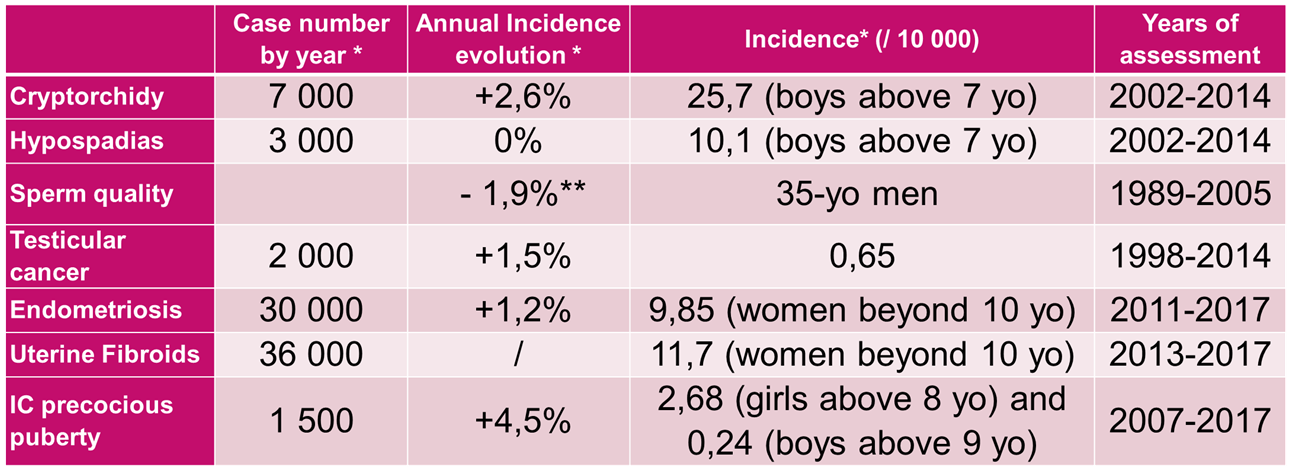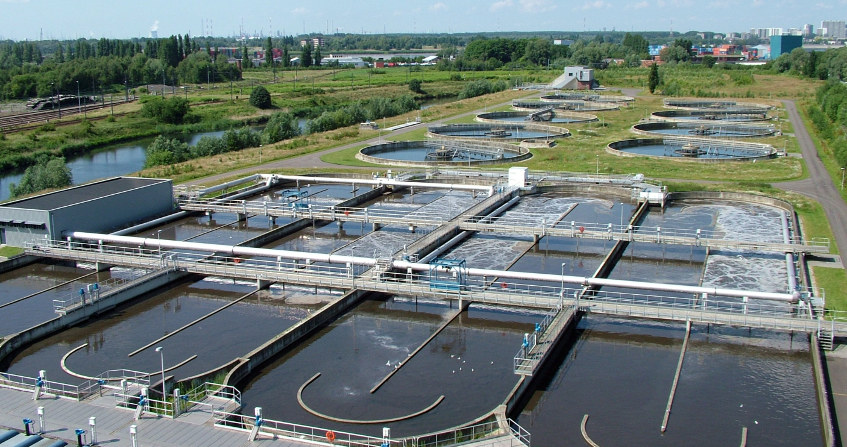Endocrine disruptors and human health
PDF
In recent years, the impact of endocrine disruptors on health has been of increasing interest to physicians, researchers and citizens. These substances interact with the endocrine system and can cause adverse effects on development, reproductive health or even promote the development of certain diseases such as certain cancers. Endocrine disruptors are widely present in the environment and food. Thus, the French population is widely exposed to them. Nevertheless, it is still difficult to estimate precisely the impact of these molecules on our health. What data are available to estimate the consequences of exposure to endocrine disruptors in the French population and what are the possible levers of action to protect the population from exposure to these molecules?
- 1. Recognition of the concept of endocrine disruptor
- 2. From exposure to endocrine disruptors to the effect on human health: principles of monitoring
- 3. What do the data on monitoring exposures and effects of endocrine disruptors on human health show?
- 4. Informing and preventing to protect the health of all
- 5. Messages to remember
1. Recognition of the concept of endocrine disruptor
The endocrine system consists of a set of organs (hypothalamus, pituitary, thyroid, adrenal glands, …) that secrete chemical substances called hormones. It is essential to life because these hormones regulate many essential functions of the body such as growth, behavior, reproduction or embryonic development. Some chemicals present in our environment have the ability to interact with the endocrine system and in doing so, will disrupt its functioning, leading to a wide range of potential undesirable effects for the body. These substances are called endocrine disruptors and can disrupt all endocrine functions:
- Reproductive functions
- Thyroid functions
- Adrenal functions
- Metabolism
- Neurodevelopment, etc.
Through these effects, they are suspected of contributing to numerous chronic or developmental pathologies: hormonal disorders and their consequences (infertility, early puberty, obesity, thyroid disease…), but also congenital malformations, hormone-dependent cancers, and even immune disorders.
In 1991, twenty scientists reached the Wingspread consensus which conceptualized the notion of endocrine disruptors. The statement mentions, among other things, that “Alterations in health and embryonic development result from chemicals released into the environment that act on the endocrine system“ [1]. The commonly accepted definition since then is the one of the World Health Organization, proposed in 2002, updated in 2012: “an EP is a substance or a mixture of substances, which alters the functions of the endocrine system and thereby induces adverse effects in an intact organism, in its offspring or in (sub)-populations.”
In 2019, the European Union adopted a regulatory definition of endocrine disruptors. Thus, for a substance to be identified as an endocrine disruptor, the available data on that substance must allow the identification of an adverse effect on an organism of integrity, an endocrine disruptor mode of action, and a biological plausibility link between the two. It is also necessary to demonstrate the relevance to humans or to a population according to the level of evidence of the effects observed in animal or cellular models. The challenges of this concept for risk management and its translation into methodologies and experimental tests leading to the classification of substances in European regulations are due in particular to the multiplicity of substances likely to be endocrine disruptors (a dozen officially recognized in the European Union, several hundred candidate substances) [2].
Of natural or synthetic origin, endocrine disruptors can be found in many everyday objects and products (household products, detergents, crop treatment products, cosmetics, food products, etc.) (Figure 1). They are also present in the environment as a result of contamination of various media (water, sediment, soil, air, etc.). The national biomonitoring program has shown a generalized exposure of the population [3], especially children, to some of these endocrine disruptors (phthalates, bisphenols, pesticides, PCBs, etc.).
2. From exposure to endocrine disruptors to the effect on human health: principles of monitoring
2.1. Complex health effects to identify
Endocrine disruptors are likely to cause a wide range of health effects. The ability of a substance to disrupt endocrine activity depends on the concentration in the biological system. At the intracellular level, endocrine disruptors can interfere with nuclear receptors, membrane receptors, intracellular signaling pathways and modulate gene expression. The link between endocrine disruptor exposure and health effects remains difficult to quantify precisely for three main reasons:
- The first reason relates to the characterization of endocrine disruptor toxicity: dose-response relationships may escape linearity contrary to the usual toxicity properties of xenobiotics or induce epigenetic effects that are transmitted to future generations.
- The second reason relates to the latency period between exposure and the onset of health effects: in particular, exposures during the “first 1000 days” period, which extends from prenatal development to early childhood, and the pubertal period is particularly critical because several peripheral or central systems (reproductive system, hypothalamo-hypophyseal axis…) complete their maturation during this period under the influence of sex steroid hormones [4].
- The third reason is the diversity of sources of endocrine disruptors and determinants causing health effects identified in the literature and distinct from exposures to endocrine disruptors.
All these specificities explain, in part, the contradiction of the results of the different studies and the difficulty of verifying the plausibility of the dose-response relationships or of defining a threshold of exposure without risk.
2.2. Health indicators are nevertheless available to guide decision-making
Measuring the health impact of these substances is not simple, and monitoring therefore relies on the collection, construction, analysis, interpretation and dissemination of indicators that encompass both exposure and potentially associated health effects. The objective sought through the construction or analysis of indicators is the simplified representation of one or more phenomena on a relative scale based on numerical information in accordance with one or more assessment criteria [5]. Indicators are thus useful metrics for the definition, implementation and evaluation of public policies or the communication of scientific and technical information to stakeholders. Health-environment indicators are developed to facilitate long-term health-environment monitoring and surveillance , to guide health- or environment-related decisions or to assess the impacts of environmental risk management decisions in a comprehensive manner [6]. Indicators rely on the availability of representative, quality data. The existence of a structured data production system is often the lever for a reliable evaluation of the phenomenon to be characterized.
In monitoring, three types of data are generally used to construct indicators for the objectification of health impact:
- Environmental data, produced within the framework of environmental protection policies, reflect the contamination of environmental and exposure environments (this dimension will not be dealt with in this article),
- Human biomonitoring data that provide a direct measure of an individual’s aggregate exposure to environmental contaminants,
- Health data (clinical, biological, …) capable of informing, directly or indirectly, trends and/or temporal and/or spatial phenomena related to a health event of interest.
Cross-analysis of these data allows a better global vision of the estimation of health impacts and potentially to examine possible relationships between health and environment. In surveillance, this approach is part of the recent scientific discipline of Environmental Public Health Tracking, described by McKone and Ozkaynak [7].
2.3. Health indicators developed at the French level
2.3.1 Indicators of exposure to endocrine disruptors
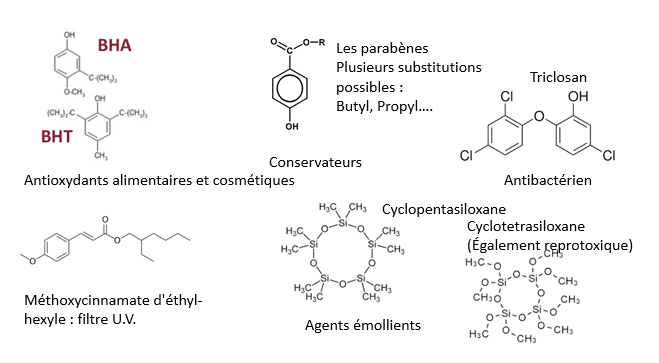
In France, it is the law resulting from the Grenelle Environment Forum (n° 2009-967 of August 3, 2009) that led to the development of a national biomonitoring program to estimate the exposure of the population to various environmental substances and to improve the understanding of exposure determinants. Included in the National Environmental Health Plan 2 and 3, the program has two components:
- A cross-sectional study in the continental general population: the Esteban study (SanTé Study on the Environment, Biosurveillance, Physical Activity and Nutrition),
- The Elfe cohort (French longitudinal study since childhood).
In this program, more than a hundred biomarkers were prioritized for measurement in the blood, urine or hair of participants, mainly because of their proven or presumed toxicity. Among them were numerous chemical substances suspected of having endocrine disrupting properties, such as bisphenols, phthalates, parabens, brominated compounds, perfluorinated compounds [8]. The objectives of this program are to describe the exposure of the population to these substances, to study the determinants of this exposure and to compare the results obtained with those of foreign programs.
A previous study, the National Nutrition and Health Study (ENNS), measured exposure to certain metals and pesticides in adults aged 18 to 74 years and mercury in children aged 6 to 17 years (Table 1).
Table 1. Chemical groups of biomarkers measured according to the different biomonitoring studies.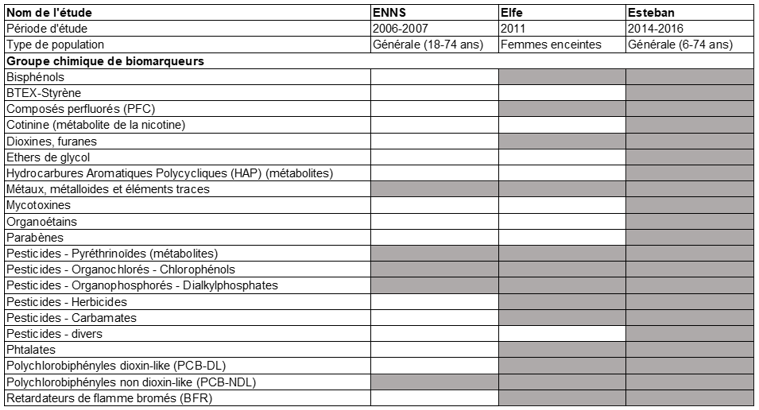
2.3.2 Indicators of health effects
Many studies describe a probable link between exposure to some of these endocrine disruptors and fertility and reproductive disorders. For this reason, in 2011 the Minister in charge of health referred to Santé publique France the reproductive health indicators of testicular dysgenesis syndrome: testicular cancer, urogenital malformations and sperm quality.
Based on this initial work, a general analysis approach was established:
- Identification and prioritization of health effects from the scientific literature and on the basis of expert consultation,
- Cross-analysis of available data sources and development of methods for the construction of health indicators, relying in particular on the external expertise of clinicians specialized in the management of pathologies,
- The estimation of the incidences and the analysis of the spatio-temporal trends of the risk on the whole territory.
Surveillance has been expanded, following a prioritization of key indicators for reproductive health, based on the weight of evidence, carried out in the framework of the international Hurgent network in 2016 [9].
3. What do the data on monitoring exposures and effects of endocrine disruptors on human health show?
3.1. The national biomonitoring program
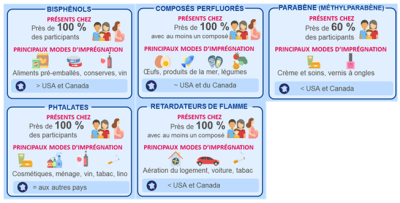
Regarding the second component of the national biomonitoring program, the target population of the Esteban study consisted of all persons residing in continental France aged 6-74 years over the 2014-2016 study period [11]. Bisphenols, phthalates, brominated flame retardants, perfluoroids, glycol ethers, and parabens were measured for the first time in France in children and adults in a large sample. The results showed generalized exposures and generally higher levels of impregnation in children, except in the case of perfluorinated compounds, which could be explained by: more frequent skin and “hand-to-mouth” contact with everyday products (toys, paints, etc.); greater exposure to house dust and a lower body weight compared to their dietary intake for most of the substances measured.
The exposure levels measured in Esteban for the six families of pollutants mentioned above were comparable to those observed in foreign programs, particularly in the United States and Canada, with the exception of brominated flame retardants, bisphenols S and F and parabens, which were less frequently found in France. These differences could be due to different regulations in different countries (for example, European regulations are more restrictive regarding the use of parabens in food), but also to different behaviors from one country to another (Figure 2).
Such analyses on representative samples are cumbersome, costly and technically difficult to characterize exposure at fine spatial resolutions and on the scale of large territories. Furthermore, biomonitoring studies as constructed today produce exposure results by substance or by families of substances and are limited to study multiexposure, closer to the real situation of human exposure.
A first assessment has recently been published, with a combined analysis of the 4 indicators of testicular dysgenesis syndrome [12] (Table 2), showing a progressive alteration of male reproductive health in France, and probably since the 1970s with regard to sperm quality (Figure 3) [12].
Table 2. Key figures for reproductive health surveillance. * Cases and incidences estimated from treated or operated cases registered in the SNDS. They do not represent the exhaustiveness of cases encountered in the general population. [Source: © Le Moal et al, 2018 ref [12], DR Santé publique France |
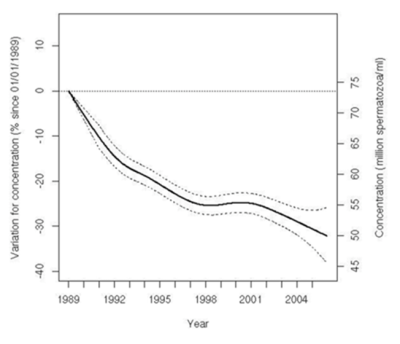
The results obtained in France do not show any obvious spatial convergence between the indicators in metropolitan France. The regions showing a more marked deterioration in semen quality over the period 1989-2005 are different from those with over-incidences of testicular cancer (Figure 4), cryptorchidism (Figure 5) [13] and hypospadias in 2014.
Different causes are possible or may be intertwined with environmental hypotheses, such as smoking in pregnant women, which is a suspected risk factor for cryptorchidism as well as for semen quality, nutritional or metabolic factors, air pollution or lifestyle changes (sedentary lifestyle, stress, heat, sleep) for semen quality [14]. At this stage, the results do not allow to argue a possible role of geographically determined exposures in the particular association of TDS components, possibly due to the limitations of the available data.

The surveillance program was able to show the increased incidence of chronic diseases plausibly attributed, at least in part, to endocrine disruptors (although the current state of knowledge of such descriptive studies can obviously only be hypothesis generating). At this stage, attributing part of the impacts to endocrine disruptor exposure, even qualitatively, through these approaches remains complicated. With the exception of semen quality, the indicators are constructed from data available in the National Health Data System (SNDS) database, which is the only data produced continuously and covers the entire country. These indicators reflect only the cases managed, significantly underestimating the public health problem because the number of patients suffering from these pathologies may be greater.
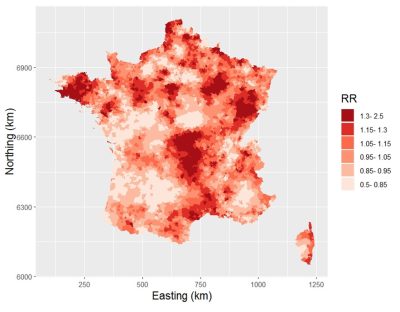
The other indicators reflect only the cases managed, significantly underestimating the public health problem because the number of patients suffering from these pathologies is much larger. Several limitations related to the method of identifying cases via the SNDS can also be listed: variations in coding, diversity of medical practices, diagnosis or management, etc. Spatio-temporal analyses at infra-departmental resolution (commune, postal code, canton) facilitate the identification of hypotheses on potential risk factors (reduction of the so-called ecological bias but increase in the uncertainty of the estimation of indicators), on the limitations of the data mobilized, or on the impact of territorial disparities in medical care. The integration of other complementary data sources (cohorts, registers, local field data, etc.) will improve the robustness and representativeness of the indicators by reducing the associated uncertainty.
4. Informing and preventing to protect the health of all
The potential health effects of endocrine disruptors were initially highlighted by the dysfunction of the reproductive sphere, but now extend to many other organs and functions of the body (alteration of the immune system, thyroid disorders, hormone-dependent cancers, etc.). Neurological disorders such as autism, reduced intelligence quotient or metabolic disorders such as diabetes or obesity are also suspected to be associated with exposure to endocrine disruptors. In order to integrate new scientific knowledge, the agency wishes to define a new strategy for monitoring the effects of endocrine disruptors (Extend the monitoring to other pathologies related to endocrine disruptors: Action 46 of SNPE 2) based on previously prioritized effects and on a broad consultation of experts and stakeholders in the field of endocrine disruptors via the Delphi consensus method [17].
Concerning the production of exposure indicators, the biomonitoring program has provided first measurements in the population for most endocrine disruptors. The repetition of biomonitoring surveys will make it possible to measure changes in exposure over time and to evaluate public policies. It will also be possible to better take into account multiple exposures and to obtain sub-national indicators by organizing a survey system in cycles, which is more flexible and allows for more frequent data acquisition. Coupled with the concept of the exposome (see Exposome and social sciences: the promise of a meeting?), the concept of endocrine disruption has led to the development of a more integrated analysis design combining epidemiology, expology and toxicology, a transdisciplinarity notably promoted in the framework of European research programs (FP7, H2020, Greendeal). The application of the exposome concept to surveillance involves combining all available data and different methodological approaches. The emergence of new environmental and toxicological databases will allow better spatialization of the populations multiexposure, but requires prior reflection on the technical needs for the exploitation of massive data, the construction of composite exposure indicators and the interoperability of tools and data from different sources and types. Finally, environmental burden assessment methods quantifying the health impact make it possible to jointly use exposure data, incidence data and epidemiological relationships to translate into an economic cost the cases attributable of a pathology to the different risk factors. This approach permits to integrate the various tools and data developed on the subject of endocrine disruptors.
Without waiting for the results of these different perspectives, informing and preventing the population’s exposure (especially the most vulnerable populations) to endocrine disruptors is already essential. Indeed, the surveillance programs presented above have been able to show the increase in the prevalence or incidence of many chronic diseases regularly attributed, at least in part, to endocrine disruptors (even if the current state of knowledge of such descriptive studies can obviously only be hypothesis generating) which implies preventive actions. For this purpose, Santé publique France has put online on September 15, 2021 a site for parents and future parents (1000 first days). This site is designed to meet the information needs related to scientific knowledge on the first 1000 days and to allow future parents to act on a daily basis to move towards a sobriety of chemical exposure with regard to the risks related to this exposure.
Exposure assessment and impact assessment are two complementary approaches, with their own limitations, to support public policy. The articulation of these different methodologies and tools in a global approach offers interesting perspectives for identifying effective prevention strategies and actions in a context of uncertainty and lack of knowledge. Finally, the degradation of the environment and the contamination of foodstuffs (particularly animal products) have a direct impact on human health. Beyond the observation of the close interdependence between human health and ecosystems, the concept of a single health and its application in decision support logics imply the need to develop integrated approaches to characterize these interrelationships.
5. Messages to remember
- The potential health effects of endocrine disruptors were initially highlighted by the dysfunction of the reproductive sphere, but now extend to many other organs and functions of the body.
- Three types of data are generally used to construct indicators for the objectification of health impact: environmental, biomonitoring and health data.
- National programs have shown a generalized exposure of the population to endocrine disruptors and an increase in the incidence of chronic diseases plausibly attributed, at least in part, to endocrine disruptors.
- Thus, and despite the uncertainties that still exist today to estimate the health impact of endocrine disruptors, the combined analysis of the results already obtained in the monitoring programs offers interesting perspectives to identify in fine information strategies and prevention actions to protect the health of all, and in particular the most vulnerable populations.
Notes & References
Cover image. Larissa Sampaio, Pixabay
[1] Bern H., et al. “Statement from the work session on chemically-induced alterations in sexual development: The wildlife/human connection”. In: Colborn T., Clement C., (eds.). Chemically-Induced Alterations in Sexual and Functional Development: The Wildlife/Human Connection. USA, New Jersey: Princeton Scientific Publishing Co, 1992, 1-8.
[2] Slama R. Endocrine disruptors: issues in European regulation. Adsp, Sept 2021, 115, 36-40.
[3] Fillol C, Oleko A, Saoudi A, et al. Exposure of the French population to bisphenols, phthalates, parabens, glycol ethers, brominated flame retardants, and perfluorinated compounds in 2014- 2016: Results from the Esteban study. Environ Int 2021; 147: 106340.
[4] Delpierre C., Lepeule J., Cordier S., et al.” DOHaD. Recent contributions of epidemiology”. Medicine/Science, Jan. 2016, 1, 32, 21-26.
[5] Nardo M, Saisana M, Saltelli A, et al. Handbook on Constructing Composite Indicators. Methodology and User Guide. OECD Statistics Working Paper, 2008.
[6] World Health Organization. Environmental Health Indicators: Framework and Methodologies. Geneva: World Health Organization, 1999.
[7] McKone TE, Ozkaynak RP. Exposure information in environmental health research: current opportunities and future directions for particulate matter, ozone, and toxic air pollutants. J Expo Sci Environ Epidemiol 2009; 19: 30-4.
[8] Fillol C, Garnier R, Mullot JU, et al. Prioritization of the biomarkers to be analyzed in the French biomonitoring program. Biomonitoring 2014; 1: 95-104.
[9] Le Moal J, Sharpe RM, Jørgensen N, et al. Toward a multi-country monitoring system of reproductive health in the context of endocrine disrupting chemical exposure. Eur J Public Health. 2016; 26(1):76-83.
[10] Dereumeaux C, Saoudi A, Pecheux M, et al. Biomarkers of exposure to environmental contaminants in French pregnant women from the Elfe cohort in 2011. Environment international. 2016; 97:56-67.
[11] Balicco A, Oleko A, Szego E, Boschat L, Deschamps V, Saoudi A, Zeghnoun A, Fillol C: Esteban protocol: a cross-sectional health study on environment, biomonitoring, physical activity and nutrition (2014-2016). Analytical and Clinical Toxicology 2017, 29: 517-537.
[12] Le Moal J et al. 2018. Combined analysis of the four indicators of testicular dysgenesis syndrome in France in the context of endocrine disruptor exposure: cryptorchidism, hypospadias, testicular cancer, and semen quality.
[13] Le Moal J, Goria S., Guillet A, Rigou A, Chesneau J. Spatiotemporal variations in the risk of cryptorchidism operated on in France and environmental hypotheses. Saint-Maurice: Santé publique France, 2021. 42 p. Available from URL: www.santepubliquefrance.fr
[14] Skakkebaek NE, Rajpert-De Meyts E, Buck Louis GM, Toppari J, Andersson AM, Eisenberg ML, et al. Male reproductive disorders and fertility trends: Influences of environment and genetic susceptibility. Physiol Rev. 2016; 96(1):55-97.
[15] Le Moal J, Goria S, Chesneau J, Peyronnet A, Fauconnier A, Kvaskoff M, De Crouy-Chanel P, Kahn V, Daraï E, Canis M. National surveillance of pathologies possibly related to endocrine disruptors : Epidemiology of endometriosis managed in hospitals in France from 2011 to 2017. Saint-Maurice: Santé publique France, 2021. 49 p.
[16] Peyronnet A, Goria S, Chesneau J, Canis M, Kahn V, Kvaskoff M, Le Moal J. National surveillance of pathologies possibly related to endocrine disruptors: Epidemiology of medically managed uterine fibroid in France from 2013 to 2017. Saint-Maurice: Santé publique France, 2021. 59 p. Available from URL: www.santepubliquefrance.fr
[17] Le Barbier M, Ménard C, Peyronnet A. PEPS’PE study: Prioritization of health effects to be monitored within the framework of the Santé publique France monitoring program related to endocrine disruptors – Methodological report. Saint-Maurice: Santé publique France, 2021. 29 p.
The Encyclopedia of the Environment by the Association des Encyclopédies de l'Environnement et de l'Énergie (www.a3e.fr), contractually linked to the University of Grenoble Alpes and Grenoble INP, and sponsored by the French Academy of Sciences.
To cite this article: CAUDEVILLE Julien, FILLOL Clemence, DENYS Sebastien (June 21, 2023), Endocrine disruptors and human health, Encyclopedia of the Environment, Accessed July 27, 2024 [online ISSN 2555-0950] url : https://www.encyclopedie-environnement.org/en/health/endocrine-disruptors-human-health/.
The articles in the Encyclopedia of the Environment are made available under the terms of the Creative Commons BY-NC-SA license, which authorizes reproduction subject to: citing the source, not making commercial use of them, sharing identical initial conditions, reproducing at each reuse or distribution the mention of this Creative Commons BY-NC-SA license.





